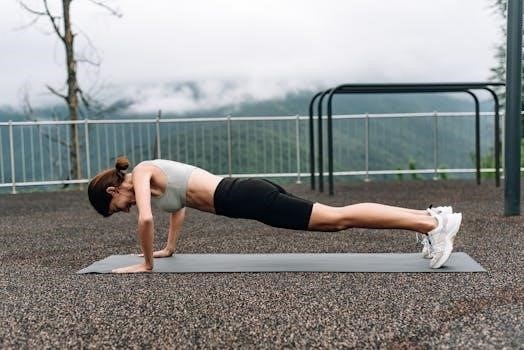What is Calisthenics?
Calisthenics originates from ancient Greece, particularly the Spartan era, focusing on beautiful movements․ It’s a low-impact workout using bodyweight for resistance․ It improves strength, flexibility, and endurance, requiring minimal space, making it accessible and adaptable for busy lifestyles․
Definition and Origins
Calisthenics, derived from the Greek words “kallos” (beauty) and “sthenos” (strength), represents a form of exercise utilizing bodyweight for resistance․ Its origins trace back to ancient Greece, specifically the Spartan era, where physical fitness was highly valued․ The practice involves performing rhythmic movements and exercises, aiming to develop strength, flexibility, and coordination․
Historically, calisthenics served as a fundamental training method for soldiers and athletes, emphasizing functional fitness and body control․ Over time, it evolved into a versatile workout suitable for individuals of all fitness levels․ Calisthenics focuses on mastering bodyweight movements․ This allows for accessible and adaptable routines․
Benefits of Calisthenics Training
Calisthenics offers a multitude of benefits, making it a popular choice for fitness enthusiasts․ Firstly, it enhances functional strength, improving the ability to perform everyday activities with ease․ Secondly, calisthenics increases flexibility and mobility, reducing the risk of injuries and promoting better posture․
Additionally, it requires minimal equipment, making it accessible anywhere, anytime․ This makes it an ideal option for home workouts or outdoor training․ Calisthenics improves muscular endurance through high repetitions․ Calisthenics also promotes body awareness and control, fostering a deeper connection with one’s physical capabilities․ Ultimately, calisthenics provides a comprehensive approach to fitness․ It improves strength, flexibility, and overall well-being, accessible and adaptable․

Calisthenics Workout Plan PDFs for Beginners
Beginner calisthenics focuses on building a foundation of strength and proper form․ PDFs offer structured plans for gradual progression․ They ease you into routines, develop strength and fitness, and often require no equipment, making starting easy․
Essential Exercises for Beginners
For beginners embarking on a calisthenics journey, mastering fundamental exercises is crucial․ These exercises establish a solid base for more advanced movements․ Key exercises include push-ups to build chest and tricep strength, squats for leg power, and planks to develop core stability․ Lunges enhance leg strength and balance, while rows target back muscles․ These exercises form the cornerstone of a beginner calisthenics routine․ Focus on perfect form over quantity to prevent injuries and ensure proper muscle engagement․ Gradually increase repetitions and sets as strength improves, laying a strong groundwork for future progress in calisthenics training․ Remember to warm up before each session․
Sample Beginner Workout Routine (PDF Download)
To help you get started, a sample beginner workout routine is available for PDF download․ This routine focuses on building a foundation of strength and endurance․ It includes exercises like push-ups, squats, planks, lunges, and rows․ Perform each exercise for a specified number of repetitions and sets, with adequate rest in between․ The PDF provides detailed instructions and illustrations for each movement, ensuring proper form and technique․ This routine is designed to gradually ease you into calisthenics․ The workout can be performed at home or in a park․ Remember to consult with a healthcare professional before starting any new exercise program, especially if you have underlying health conditions․
Building a Foundation of Strength and Endurance
Building a solid foundation in calisthenics is crucial for long-term progress and injury prevention․ This involves focusing on mastering fundamental movements and gradually increasing the difficulty over time․ Consistency is key to developing strength and endurance․ Start with bodyweight exercises like push-ups, squats, and planks, focusing on proper form․ Gradually increase the number of repetitions and sets as you get stronger․ Incorporate variations of these exercises to challenge different muscle groups․ Be patient and persistent, as it takes time to build a strong foundation․ Remember to prioritize rest and recovery to allow your body to adapt and rebuild․ This foundation will enable you to progress to more advanced calisthenics exercises safely and effectively․

Intermediate Calisthenics Workout Plans
Intermediate calisthenics builds upon foundational strength․ It incorporates progressive exercises, increasing difficulty and intensity․ These plans often include full-body routines, challenging various muscle groups․ Focus is on mastering more complex movements for continued progress․
Progressive Calisthenics Exercises
Progressive calisthenics involves gradually increasing the difficulty of exercises to continually challenge your muscles and promote strength gains․ This might include transitioning from standard push-ups to incline or decline push-ups, or from basic squats to pistol squats․ Mastering each progression before moving to the next is crucial․
Consider pull-up progressions like negatives, assisted pull-ups, and eventually unassisted pull-ups․ Similarly, leg raises can progress from bent-knee raises to straight-leg raises and eventually hanging leg raises․ Focus on proper form throughout each progression to minimize the risk of injury and maximize effectiveness․
Adding weight vests or resistance bands can also increase the intensity․
Full-Body Intermediate Workout Routine (PDF)
An intermediate calisthenics workout routine should target all major muscle groups, typically performed three times per week with rest days in between․ Exercises can include variations of push-ups, pull-ups, squats, and planks․ This PDF will provide a structured plan to enhance strength, balance, flexibility, and muscle growth․
The routine may incorporate exercises like diamond push-ups for chest, Australian pull-ups for back, and lunges for legs․ Core work should include planks and Russian twists․ Sets and reps will be structured to challenge you while maintaining proper form․ Download the PDF for detailed instructions and progression tips․
Increasing Difficulty and Intensity
Progressing in calisthenics involves several strategies to increase difficulty and intensity․ One method is to add repetitions per set, gradually pushing your endurance․ Another is to increase the number of sets for each exercise, further challenging your muscles․ Introducing new variations of familiar exercises can also significantly elevate the intensity․
For example, moving from regular push-ups to decline push-ups or adding resistance with a weight vest․ Reducing rest time between sets and incorporating supersets or circuits is also effective․ Focusing on explosive movements and plyometrics can develop power․ These combined strategies ensure continuous progress and prevent plateaus in your calisthenics journey․

Advanced Calisthenics Workout Plans
Advanced calisthenics pushes limits with complex movements․ These plans often incorporate skills like the human flag․ They require mastery of foundational exercises, focusing on pushing limits․ They aim to achieve mastery through intense training․
Complex Movements and Skills
Advanced calisthenics transcends basic exercises, venturing into complex movements and skills․ These advanced routines often incorporate challenging feats like the human flag, planche, and muscle-ups, demanding a high level of strength, coordination, and body control․ Mastering these movements requires dedication, consistent training, and a solid foundation in fundamental calisthenics exercises․
These routines push the boundaries of what’s possible with bodyweight training, requiring athletes to develop exceptional strength and control․ Progressing to these skills involves breaking down complex movements into smaller, manageable steps, focusing on proper form and technique․ Patience is key as these skills can take months or even years to master․
Advanced Calisthenics Workout (PDF)
An advanced calisthenics workout PDF provides a structured routine for athletes seeking to push their limits․ This PDF contains exercises like muscle-ups, handstand push-ups, and levers, requiring significant strength and skill․ The plan often includes progressions and regressions to tailor exercises to individual abilities․
The PDF also includes detailed instructions, sets, reps, and rest periods․ It emphasizes proper form to prevent injuries and maximize results; Many plans offer variations to keep workouts challenging․ It also offers guidance on warm-up and cool-down routines․ This comprehensive guide is designed to help athletes achieve mastery․
Pushing Limits and Achieving Mastery
Advanced calisthenics involves complex movements, demanding exceptional strength, control, and coordination․ Progressing requires consistent practice, dedication, and a deep understanding of body mechanics․ This phase focuses on mastering skills like the human flag, planche, and one-arm pull-up․
Achieving mastery means refining technique, increasing strength, and improving overall body awareness․ It requires pushing beyond comfort zones while maintaining proper form․ Advanced training often incorporates weighted calisthenics to further challenge the muscles․ This level is about continuous improvement and striving for peak physical performance through bodyweight training․

Creating a Personalized Calisthenics Plan
Personalized calisthenics requires assessing your current fitness level and defining clear goals․ Consider strength, endurance, flexibility, and skill aspirations․ Tailor your workout plan to match your abilities and objectives for effective progress․
Assessing Fitness Level and Goals
Before embarking on a calisthenics journey, a thorough self-assessment is crucial․ Honestly evaluate your current strength, flexibility, and endurance․ Can you perform basic exercises like push-ups, squats, and planks with proper form? Identify any limitations or injuries that might affect your training;
Next, define specific, measurable, achievable, relevant, and time-bound (SMART) goals․ Do you aim to increase muscle mass, improve functional strength, master advanced skills like handstands, or simply enhance overall fitness?
Your fitness level and goals will dictate the appropriate starting point and progression within your personalized calisthenics plan․ Adjust exercises and intensity accordingly for optimal results․
Structuring Your Workout Week
Creating a structured workout week is vital for consistent progress in calisthenics․ Determine the number of training days based on your fitness level, goals, and recovery capacity․ Beginners may start with three sessions per week, while more advanced individuals can increase frequency․
Divide your workouts strategically, incorporating full-body routines or splitting exercises by muscle group (e․g․, upper/lower body, push/pull)․ Ensure adequate rest between sessions to allow for muscle recovery and prevent overtraining․
Consider incorporating active recovery days with light activities like stretching or yoga․ A well-structured week maximizes gains while minimizing the risk of injury, promoting long-term adherence to your calisthenics plan․
Tracking Progress and Making Adjustments
Monitoring your progress is essential for optimizing your calisthenics journey․ Keep a detailed workout log, noting exercises, sets, reps, and any variations․ Track your performance over time to identify improvements or plateaus․
Regularly assess your strength, endurance, and skill level․ Consider using a fitness app or journal to record data and visualize trends․ Pay attention to your body’s feedback, including soreness, fatigue, and any signs of injury․
Adjust your workout plan based on your progress and needs․ If you’re consistently exceeding your goals, increase the difficulty or volume․ If you’re struggling, modify exercises or reduce intensity․ Adaptability ensures continued growth and prevents stagnation in your calisthenics practice․